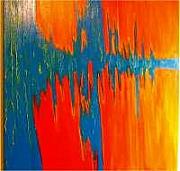 Yesterday a rocking unusual — a shaker way-too-close to the barn. Just 16 miles away from me, myself and I was a 3.0 earthquake, and though no damage or much movement detected, my fright level was after-the-fact off the charts.
Yesterday a rocking unusual — a shaker way-too-close to the barn. Just 16 miles away from me, myself and I was a 3.0 earthquake, and though no damage or much movement detected, my fright level was after-the-fact off the charts.
Details at the USGS.
And to increase the shaker-paranoia, check out the latest quakes all over California, including the 4.2-magnitude which popped Fontana Saturday morning. No damage there, either, just “…some reasonable shaking,” and more fright.
On the terror-road to the real-big one.
(Illustration: ‘Earthquake,’ by Jakara Art, found here).
Although the San Andreas Fault is the showcase fright for all of us — grasping at the horror is a new geological forecast for the US West Coast.
Via the New Yorker:
Just north of the San Andreas, however, lies another fault line.
Known as the Cascadia subduction zone, it runs for seven hundred miles off the coast of the Pacific Northwest, beginning near Cape Mendocino, California, continuing along Oregon and Washington, and terminating around Vancouver Island, Canada.
The “Cascadia” part of its name comes from the Cascade Range, a chain of volcanic mountains that follow the same course a hundred or so miles inland.
The “subduction zone” part refers to a region of the planet where one tectonic plate is sliding underneath (subducting) another.
Tectonic plates are those slabs of mantle and crust that, in their epochs-long drift, rearrange the earth’s continents and oceans.
Most of the time, their movement is slow, harmless, and all but undetectable. Occasionally, at the borders where they meet, it is not.
…
In the Pacific Northwest, the area of impact will cover* some hundred and forty thousand square miles, including Seattle, Tacoma, Portland, Eugene, Salem (the capital city of Oregon), Olympia (the capital of Washington), and some seven million people.
When the next full-margin rupture happens, that region will suffer the worst natural disaster in the history of North America.
Roughly three thousand people died in San Francisco’s 1906 earthquake.
Almost two thousand died in Hurricane Katrina.
Almost three hundred died in Hurricane Sandy.
FEMA projects that nearly thirteen thousand people will die in the Cascadia earthquake and tsunami.
Another twenty-seven thousand will be injured, and the agency expects that it will need to provide shelter for a million displaced people, and food and water for another two and a half million.
“This is one time that I’m hoping all the science is wrong, and it won’t happen for another thousand years,” Murphy says.
The piece is a long-read, but worth the InterWeb time. And scary…